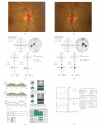Leber's Hereditary Optic Neuropathy-Gene Therapy: From Benchtop to Bedside
- PMID: 21253496
- PMCID: PMC3021870
- DOI: 10.1155/2011/179412
Leber's Hereditary Optic Neuropathy-Gene Therapy: From Benchtop to Bedside
Abstract
Leber's hereditary optic neuropathy (LHON) is a maternally transmitted disorder caused by point mutations in mitochondrial DNA (mtDNA). Most cases are due to mutations in genes encoding subunits of the NADH-ubiquinone oxidoreductase that is Complex I of the electron transport chain (ETC). These mutations are located at nucleotide positions 3460, 11778, or 14484 in the mitochondrial genome. The disease is characterized by apoplectic, bilateral, and severe visual loss. While the mutated mtDNA impairs generation of ATP by all mitochondria, there is only a selective loss of retinal ganglion cells and degeneration of optic nerve axons. Thus, blindness is typically permanent. Half of the men and 10% of females who harbor the pathogenic mtDNA mutation actually develop the phenotype. This incomplete penetrance and gender bias is not fully understood. Additional mitochondrial and/or nuclear genetic factors may modulate the phenotypic expression of LHON. In a population-based study, the mtDNA background of haplogroup J was associated with an inverse relationship of low-ATP generation and increased production of reactive oxygen species (ROS). Effective therapy for LHON has been elusive. In this paper, we describe the findings of pertinent published studies and discuss the controversies of potential strategies to ameliorate the disease.
Figures



Similar articles
-
The mitochondrial ND6 gene is a hot spot for mutations that cause Leber's hereditary optic neuropathy.Brain. 2001 Jan;124(Pt 1):209-18. doi: 10.1093/brain/124.1.209. Brain. 2001. PMID: 11133798
-
Identification of novel mitochondrial mutations in Leber's hereditary optic neuropathy.Mol Vis. 2010 Apr 30;16:782-92. Mol Vis. 2010. PMID: 20454697 Free PMC article.
-
[The influence of mitochondrial haplogroup on Leber's hereditary optic neuropathy].Zhonghua Yi Xue Yi Chuan Xue Za Zhi. 2008 Feb;25(1):45-9. Zhonghua Yi Xue Yi Chuan Xue Za Zhi. 2008. PMID: 18247303 Review. Chinese.
-
Complex I mutations synergize to worsen the phenotypic expression of Leber's hereditary optic neuropathy.J Biol Chem. 2020 Sep 18;295(38):13224-13238. doi: 10.1074/jbc.RA120.014603. Epub 2020 Jul 28. J Biol Chem. 2020. PMID: 32723871 Free PMC article.
-
Leber's hereditary optic neuropathy: a multifactorial disease.Prog Retin Eye Res. 2006 Jul;25(4):381-96. doi: 10.1016/j.preteyeres.2006.05.002. Epub 2006 Jul 7. Prog Retin Eye Res. 2006. PMID: 16829155 Review.
Cited by
-
The FusX TALE Base Editor (FusXTBE) for Rapid Mitochondrial DNA Programming of Human Cells In Vitro and Zebrafish Disease Models In Vivo.CRISPR J. 2021 Dec;4(6):799-821. doi: 10.1089/crispr.2021.0061. Epub 2021 Nov 30. CRISPR J. 2021. PMID: 34847747 Free PMC article.
-
Metformin may alter the course of Leber's hereditary optic neuropathy: a case report.Front Med (Lausanne). 2025 Aug 19;12:1609941. doi: 10.3389/fmed.2025.1609941. eCollection 2025. Front Med (Lausanne). 2025. PMID: 40904364 Free PMC article.
-
Mitochondrial disorders and the eye.Eye Brain. 2011 Sep 26;3:29-47. doi: 10.2147/EB.S16192. eCollection 2011. Eye Brain. 2011. PMID: 28539774 Free PMC article. Review.
-
Gene and cell-based therapies for inherited retinal disorders: An update.Am J Med Genet C Semin Med Genet. 2016 Dec;172(4):349-366. doi: 10.1002/ajmg.c.31534. Epub 2016 Nov 8. Am J Med Genet C Semin Med Genet. 2016. PMID: 27862925 Free PMC article. Review.
-
Stem Cell Ophthalmology Treatment Study (SCOTS): bone marrow-derived stem cells in the treatment of Leber's hereditary optic neuropathy.Neural Regen Res. 2016 Oct;11(10):1685-1694. doi: 10.4103/1673-5374.193251. Neural Regen Res. 2016. PMID: 27904503 Free PMC article.
References
-
- Leber T. Ueber hereditaere und congenital angelegte sehnervenleiden. Graefes Arch Ophthalmol. 1871;17:249–291.
-
- Newman NJ. Hereditary optic neuropathies: from the mitochondria to the optic nerve. American Journal of Ophthalmology. 2005;140(3):517.e1–517.e9. - PubMed
-
- Nikoskelainen E, Hoyt WF, Nummelin K. Ophthalmoscopic findings in Leber’s hereditary optic neuropathy. II. The fundus findings in the affected family members. Archives of Ophthalmology. 1983;101(7):1059–1068. - PubMed
-
- Wallace DC. A new manifestation of Leber’s disease and a new explanation for the agency responsible for its unusual pattern of inheritance. Brain. 1970;93(1):121–132. - PubMed
Grants and funding
LinkOut - more resources
Full Text Sources
Other Literature Sources
Medical

